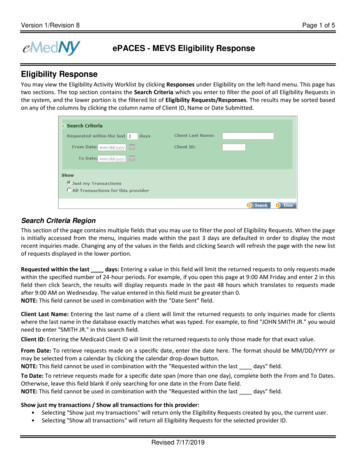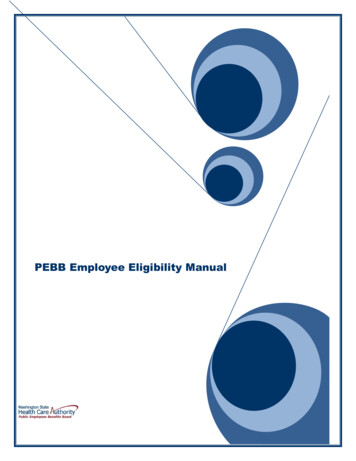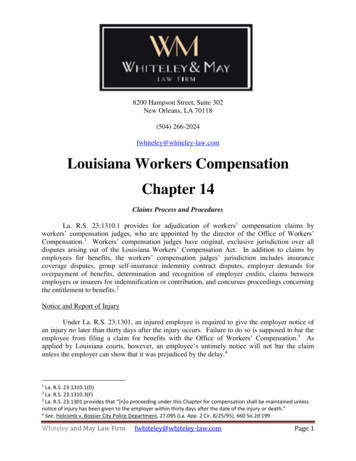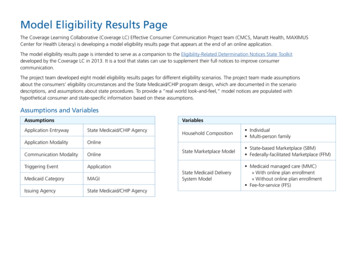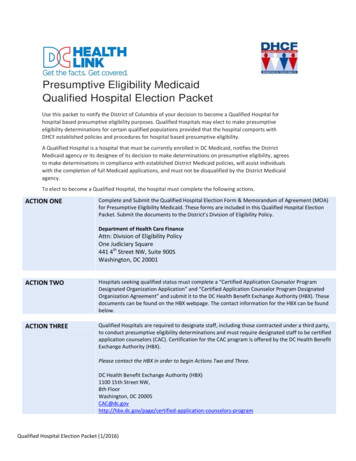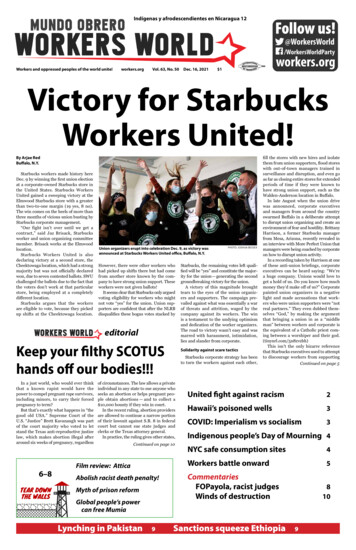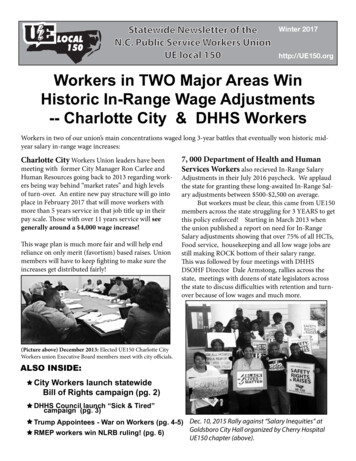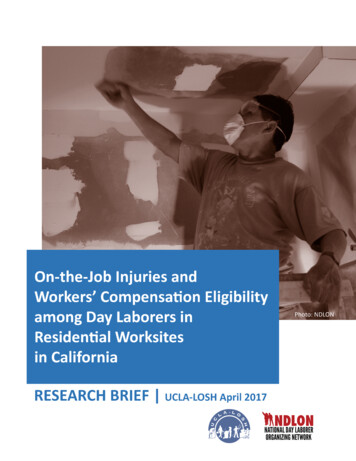
Transcription
OntheJobInjuriesandWorkers’Compensa onEligibilityamongDayLaborersinResiden alWorksitesinCaliforniaRESEARCHBRIEF UCLA-LOSHApril2017Photo:NDLON
Research BriefUCLA-LOSH April 2017On-the-Job Injuries and Workers’ Compensation Eligibility among Day Laborersin Residential Worksites in CaliforniaOverview and Key FindingsThe day labor workforce serves as an important resource in many metropolitan areas, providing valuableservices to homeowners and residential contractors. The variety of tasks day laborers perform in residentialsettings—construction, renovation, moving, landscaping—contribute to the safety, security, and beautificationof residential properties and surrounding communities. Workers themselves often take pride in thesecontributions.As with other work environments, residential worksites can pose the potential for serious injury to workers. Insome rare instances, dangerous day labor assignments have led to worker deaths.1 Yet, the information natureof most day labor work means that injuries largely go unreported and remain hidden from official public view.This research brief summarizes findings from recent efforts by the UCLA Labor Occupational Safety and HealthProgram (UCLA-LOSH) and the National Day Laborer Organizing Network (NDLON) to document the experiencesof residential day laborers in California. Interviews with 64 day laborers who were injured while working inresidential worksites in the past five years show that: Day laborers encounter a wide range of hazards in residential work settings. Respondents report heavylifting, working from heights, exposure to dust or fumes, outdoor heat, repetitive motions, anddangerous equipment and machinery among the many hazards they commonly face. The injuries that day laborers sustain at residential worksites can be serious in nature. Respondentsmost often described musculoskeletal injuries—crippling pain in the back, arms, legs, neck, orshoulders—followed by cuts/lacerations and broken bones. Three-quarters of respondents lost worktime as a result of their injuries, and 70% sought medical attention. Injuries sustained at residential worksites result in substantial costs to workers and their families.One-third of respondents said they had to pay their own medical bills. Half of respondents spent 55 ormore on medical bills; the most a respondent in our sample spent was 15,000. Many respondents alsolost work days as a result of injury, and 82% were never paid for lost work time. Half of respondents lost7 days or more from work; the most work time lost was 3 years.In addition, this research sought to assess eligibility for workers’ compensation among day laborers who areinjured in residential settings. California is one among a number of states that requires homeowners tocompensate injured workers if certain worktime and earnings thresholds have been met. Specifically, daylaborers in California are eligible for compensation if they have worked 52 hours or more for the homeowneremployer in the 90 days preceding injury and have earned 100 or more in wages. (Day laborers who are hiredby contractors for residential work assignments are automatically eligible for injury compensation through the
2 Page UCLA-LOSH April 2017contractor-employer.) Yet, many homeowners and workers may be unaware of these legal requirements,confused by the eligibility thresholds, and/or unclear about the rights of workers with undocumentedimmigration status. Some employers may also actively deny benefits to injured employees. As a result, ourresearch found that: Few workers who are injured in residential settings benefit from workers’ compensation resources.We estimate that one-third of respondents who were employed by homeowners at the time of injurywere likely eligible for workers’ compensation; an additional 26% were eligible through contractoremployers. However, only 5% indicated that workers’ compensation paid for medical bills or lost worktime.These findings indicate a need for policies and programs to both prevent debilitating injuries to workers inresidential settings and to promote greater access to compensation. One promising measure now underconsideration in the California legislature is Assembly Bill 206, which aims to remove the 52-hour worktimethreshold for workers’ compensation eligibility among residential employees and clarify that workers’compensation rights extend to those with undocumented immigration status. Our data indicate that AB206would have a marked impact: We estimate that under AB206 an additional 34% of workers that weinterviewed would be legally eligible for workers’ compensation. The proposed legislation is an important stepin both simplifying eligibility criteria in California and extending a valuable resource to reach more workers inneed.Who Comprises the Day Labor Workforce in California?Each day, an estimated 40,000 individuals seek day labor work at street corners, curbsides, and hiring centers incommunities throughout California.2 The vast majority of these individuals are undocumented male migrantsfrom Mexico and other parts of Latin America.3 California accounts for about one-third of the nation’s day laborpopulation, a ratio similar to the state’s share of the total immigrant population.2Day labor is characterized by temporary and informal work arrangements, with payments typically provided incash.3 While estimates do not exist to describe the population of employers relying on the day labor workforce,surveys with workers indicate that many day labor assignments are with homeowners or contractors providingservices in residential settings.4,5 Common tasks include construction, renovation, moving, landscaping, andproperty maintenance, tasks that are often high risk in nature.4–7 Studies have indicated that as many as one infive day laborers experience serious work-related injuries each year.4,8 Yet, few detailed studies exist on thenature and impact of these injuries.Are Residential Day Laborers Eligible for Workers’ Compensation?In the United States, workers’ compensation insurance programs originated in the early twentieth century as aresource for workers who suffer debilitating injuries and illnesses on the job. Under these state-based programs,employers are responsible for providing compensation for needed medical care and lost work time; in exchangefor access to these resources, employees forfeit their rights to sue employers under tort law. The insurancebased model in theory establishes financial incentives for employers to prevent workplace injuries—employerswith fewer workers’ compensation claims enjoy lower insurance premiums and fewer deductible payments.This traditional workers’ compensation model has been extended to residential work settings in large part bybroadening the definition of “employer” and “employee” to include homeowners and those they hire. Twenty-
UCLA-LOSH April 2017 Page 3six states now have legal provisions that extend workers’ compensation coverage to “residential employees,”which can include day laborers. Many of these states have established specific worktime or earnings thresholdsor other criteria that these workers must meet before being eligible for benefits. (See Appendix for a summaryof states with workers’ compensation provisions for residential employees.)The California Labor Code includes within its definition of “employee” those “employed by the owner oroccupant of a residential dwelling whose duties are incidental to the ownership, maintenance, or use of thedwelling” (California Labor Code §3351(d)). Homeowners’ insurance policies in California are required to includeworkers’ compensation coverage (California Insurance Code §11590). But California is currently the only statewhere workers hired by homeowners must meet both worktime and earnings thresholds for workers’compensation eligibility. Homeowner-employers are only responsible for providing compensation when anemployee has worked 52 hours or more in the 90 days immediately preceding the injury and has earned 100 ormore in wages. Employees that do not meet both criteria are exempt ((California Labor Code §3352(h)).Day laborers who are hired by contractors to work in residential settings are automatically eligible for workers’compensation through the contractor-employer. In this case, no worktime or earnings thresholds apply.Despite these provisions, the rate of workers’ compensation access among day laborers injured in residentialwork settings is presumed to be well below the rate of injury,9,10 raising a number of questions: To what extentdo the worktime and earnings thresholds for workers’ compensation eligibility in California impact injuredworkers? What other factors contribute to this discrepancy? How can access to workers’ compensationresources be expanded for these workers in need? These questions laid the foundation for this researchinitiative.Residential Day Laborers and Workers’ Compensation Eligibility in CaliforniaDay laborers hired by homeowners in California are eligible for workers’ compensation from their homeowneremployer if:a) They have worked 52 hours or more in the 90 days immediately preceding the injury; andb) They have earned 100 or more in wages in the 90 days immediately preceding the injury.Workers who have not reached these worktime and earnings thresholds at the time of injury are exempt.Day laborers hired by residential contractors in California are eligible for workers’ compensation from theircontractor-employer regardless of hours worked or amount earned. Even workers hired under the table orthrough other informal arrangements are legally eligible. (The definition of “employee” in the California LaborCode refers to any person “in the service of an employer under any appointment or contract of hire orapprenticeship, express or implied, oral or written, whether lawfully or unlawfully employed” (California LaborCode §3351) (emphasis added)).How Did We Conduct our Research?In 2016, the UCLA Labor Occupational Safety and Health Program (UCLA-LOSH) and the National Day LaborerOrganizing Network (NDLON) set out to document the experiences of day laborers who are injured in California,and to assess discrepancies between workers’ compensation eligibility and rates of access. This brief summarizes
4 Page UCLA-LOSH April 2017some of our findings to date. We also consider the implications for proposed California legislation that aims toexpand workers’ compensation eligibility for day laborers and other residential employees.UCLA-LOSH and NDLON developed an interview tool for day laborers in California who had experienced one ormore serious work-related injuries. The tool included 36 closed- and open-ended questions regarding thehazards typically encountered on day labor assignments and details regarding the respondent’s most recentinjury experience. Questions were included to determine the respondent’s potential eligibility for formalcompensation under state law, regardless of whether compensation was received. The questionnaire alsocaptured demographic and work characteristics of each respondent.Three bilingual interviewers were hired to interview workers. Respondents were recruited through NDLONaffiliated day labor hiring centers in Southern and Northern California; interviewers also approached daylaborers waiting for work at street corners and curbsides. Individuals were eligible to participate if they haveexperienced at least one serious work-related injury while working as a day laborer in California in the previousfive years. (We define a serious work-related injury as one requiring medical attention, whether or not theindividual received medical care.) Interviews were conducted in both Spanish and English, and respondentsreceived a 15 gift card for their participation. The interviewers transferred all responses into an electronicspreadsheet for subsequent summary and analysis.A total of 106 interviews have been completed under this research project. The majority of respondents wereLatino men with a mean age of 47 years. Two thirds were from Mexico. Ninety-seven percent spoke Spanish astheir primary language, and three quarters rated their English language abilities as average or poor. Over 60%had more than 5 years of experience as a day laborer, and 36% had more than 10 years of experience.Respondents most commonly reported finding day labor jobs through hiring centers.This policy brief summarizes findings from interview with 64 day laborers (60%) who indicated that their mostrecent injuries had occurred while working at residential worksites, employed by either homeowners orresidential contractors. (The remaining 40% of respondents indicated they were injured while working as daylaborers at construction or agricultural sites, warehouses, or other work settings. We plan to conduct additionalanalysis with these data in the coming months.)Hazards in Residential Work SettingsThe day laborers we interviewed shared information about the kinds of hazards typically found while working inresidential settings (see Figure 1). Respondents most often cited heavy lifting, working from heights, exposure todust or fumes, outdoor heat, repetitive motions, dangerous equipment and machinery, and loud noise. Lesscommonly reported hazards included use of chemicals and work around high voltage electricity.The frequency with which respondents reported encountering these hazards suggests that residential settingsoften pose similar hazard profiles as more traditional construction or agricultural worksites. Adding to thesehazards, fully 62% of respondents indicated that they had experienced pressure from employers to work indangerous conditions.
UCLA-LOSH April 2017 Page 5FIGURE 1: Hazards Encountered at Residential 7%0%Many respondents provided additional comments on the most dangerous tasks they had been asked to performas day laborers:The most dangerous work involves working on roofs and up on trees without safety equipment.Use of dangerous equipment without protection.Gardening under extreme heat.Being lifted on the fork of a tractor to prune trees.Cleaning a basement with dangerous chemicals and without adequate safety equipment.Injuries at Residential WorksitesThe injuries that respondents described as resulting from work in residential settings were often serious innature (see Figure 2). Seventy-five percent of respondents sustained musculoskeletal injuries—crippling pain inthe back, arms, legs, neck, or shoulders. An additional 17% suffered cuts or lacerations, and 9% sustained brokenbones. Other less-common injuries included damage to eyes, skin rashes, and sickness. Three-quarters ofrespondents lost work time as a result of their injuries, and 70% sought medical attention.
6 Page UCLA-LOSH April 2017FIGURE 2: Nature of Most Recent InjuryMusculoskeletal (67%)Cut or laceration (15%)Broken bone (8%)Eye injury (4%)Sickness (3%)Skin rash /Itch (3%)Respondents also shared stories about the injuries they experienced. These accounts provide a valuable windowinto the nature of work in residential settings that can lead to harm for these workers:I was painting on a ladder that was about 7 feet high, and the ladder slipped because it was not in goodcondition. As the ladder fell, I jumped to avoid getting injured more seriously. I ended up twisting myankle.I was pouring cement and a piece of iron metal fell in my eye. I nearly lost my eye.I was lifting heavy objects, picking up branches and tree trunks. They told me to work fast and I picked upa very big tree trunk and my back cracked. It started to hurt the next day.I was lifting heavy items and going up stairs when I hurt a ligament in my knee. I now have chronic painin my knee, especially when it’s cold.I was demolishing a house and removing nails from a height of 10 feet. I was on top of a piece of wood,slipped, and fell on my side. I hurt my sciatic nerve, five vertebrae, and deviated three discs.I was removing a roof when it suddenly fell in. I was on top of the roof and the wood fell down. I waited40-60 minutes, but I couldn’t handle the pain and no one wanted to call an ambulance.I was helping a contractor fix the roof of a house. I was using the skill-saw to cut pieces of wood, butwasn't using the guard on the skill-saw. When I was cutting into the wood it ricocheted and cut my hand.When asked what factors they believed contributed to the injury, respondents most commonly cited fast paceof work, along with repetitive motions and heavy lifting (see Figure 3). Over one-third believed lack of propersafety gear played a role. About one-quarter pointed to working alone and working from heights as contributors.
UCLA-LOSH April 2017 Page 7FIGURE 3: Factors Contributing to Most Recent %0%Fast pace Repetitiveof work motionsHeavyliftingLack of Work from Dangerous Workingheights machinery alonepropersafety gearLack oftraining17%Lack ofpropersupervisionThe Cost of Injuries to Workers and their FamiliesOur research has found that the injuries day laborers experience in residential settings result in substantial coststo themselves and their families. Among respondents who sought medical care for their injuries, one-third saidthey paid their medical bills out of their own pockets (see Figure 4). The median amount these workers spent onmedical bills was 55, while the highest amount paid by a respondent in this sample was 15,000. One-quarter(24%) said that employers had paid for some or all of their medical bills. Only one respondent in our sampleindicated that workers’ compensation covered their medical expenses, and that individual was working for aresidential contractor at the time of injury.FIGURE 4: Who Paid for Medical Bills?Health insurance/MediCal (36%)Respondent paid all out of pocket (33%)Employer (24%)Don’t know/Not specified (4%)Workers’ comp (2%)
8 Page UCLA-LOSH April 2017The majority of day laborers we interviewed indicated they sought medical care at public clinics (33%) oremergency rooms (24%), while others reported visits to private clinics (11%), pharmacies (6%), massage-healers(sobador) (6%), and chiropractors (3%).Three-quarters of respondents also lost work time as a result of their injuries. The median amount of time lostfrom work was 7 days; the most work time lost was 3 years. Fully 82% of day laborers were never paid for thislost work time. Ten percent indicated that their employer paid for some or all lost work time, and only tworespondents said that lost work time was paid by workers’ compensation. Both of these respondents said theywere employed by homeowners at the time of injury.The financial burdens and other effects of these injuries have substantial impacts on day laborers and theirfamilies, as many respondents described:I didn’t have money for rent or food for my family during that time.I’m afraid of hurting myself again at work.When one gets hurt it is hard, one can become disabled for life, especially if it’s the back. I have backpain daily, but I have to go out and work.I lost a lot of work time. I couldn’t do what I used to be able to do. I was living in shelters and missions, Ireceived canned food to survive.I didn’t have money for rent or food and I had to live on the streets.The family came together to help me, I had limited mobility. They all took part in helping me out.I’ve suffered a lot of pain. I’ve thought of returning to Mexico because the pain doesn’t stop from myback to my feet. It hurts constantly.I’m not the same person since the injury. I’m handicapped for life.People are abusive and take advantage of day laborers, even knowing that it’s possible that we can gethurt.Workers’ Compensation Eligibility under Existing LawDespite the severity of many injuries described by respondents in our sample, only 5% indicated that workers’compensation paid for medical care or lost worktime. One goal of our research was to estimate how manyrespondents were likely eligible for workers’ compensation at the time of injury and to consider factors thatserved as hurdles to securing resources in cases when workers were eligible.As noted above, day laborers who are injured while working for contractors in residential worksites areautomatically eligible for workers’ compensation. Twenty-six percent of respondent in our sample wereemployed by residential contractors at the time of injury and were therefore eligible for compensation fromthe contractor-employer.
UCLA-LOSH April 2017 Page 9In the case of day laborers hired directly by homeowners, eligibility is determined by certain worktime andearnings thresholds—individuals who have worked less than 52 hours in the 90 days prior to injury or haveearned less than 100 are exempt from eligibility. How do these exemptions impact workers in our sample whowere injured while employed directly by homeowners?Two-thirds (68%) of day laborer respondents who had been injured while working for homeowners indicatedthey had earned more than 100 in the 90 days prior to injury. However, only one-third (36%) had worked morethan 52 hours for the homeowner-employer during that time period (see Table 1). Only 34% of respondentshired by homeowners met both worktime and earnings criteria, making them eligible for workers’compensation.TABLE 1: Workers’ Compensation Eligibility for Day Laborers Employed by HomeownersWorked lessthan 52 hoursWorked 52hours or moreTOTALEarned lessthan 10030%Earned 100or more34%TOTAL2%34%36%32%68%100%64%NOTE: The shaded cell indicates the proportion of respondents who met current legal criteria as residential employees and who weretherefore eligible for workers’ compensation.When taken together, fully half of the respondents in this sample (52%) were legally eligible for compensation atthe time of injury. However, only 5% indicated that workers’ compensation paid for medical bills or lost worktime. What factors account for this discrepancy?One important factor likely relates to workers’ and homeowners’ lack of awareness regarding legal obligationsand availability of resources. Many respondents indicated they had not told their employer about the injurybecause they felt the injury wasn’t serious enough to report or that the employer wouldn’t do anything about it.As one respondent told an interviewer, “I just didn’t want to be a bother,” while another shrugged off thesuggestion that he could have gone to his employer: “One takes one’s own risks” (“Va uno bajo su riesgo”).Respondents’ accounts of their interactions with employers following injury suggest further misunderstandingon the part of homeowners. Among respondents who were eligible for workers’ compensation fromhomeowner-employers, many reported that the homeowner drove them to a hospital or clinic for treatment,sent them home to recover, offered over-the-counter pain medication, and/or paid them extra for the day. Onlyone individual received information and paperwork from the homeowner to file a claim. (One other respondentwho reported that workers’ compensation had paid for lost work time said he had received paperwork from anattorney.)An additional factor likely contributing to low rates of workers’ compensation access is the economic and socialinsecurity many day laborers face. While two-thirds (69%) of the workers we interviewed said they reportedtheir injury to an employer or supervisor, this rate of reporting is lower than that found in studies of injuredworkers in the low-wage labor market more generally.11 Respondents commonly cited concerns about missingwork or losing their job as reasons not to tell their employers. Undocumented immigration status undoubtedlyplays a role in heightening these concerns, given the limited alternative work opportunities available to theseworkers.
10 P a g e U C L A - L O S H A p r i l 2 0 1 7What is the Anticipated Impact of AB206?Our data indicate that the proposed changes under AB206 will markedly increase workers’ compensationeligibility for day laborers who are injured while working for homeowners (see Table 2). By eliminating the 52hour requirement for eligibility, the bill will extend workers’ compensation resources to any day laborer whohad earned at least 100 from a homeowner-employer in the 90 days prior to injury. We estimate that anadditional 34% of workers we interviewed who were injured while working for homeowners would be eligiblefor workers’ compensation under AB206. This change would effectively double the rate of workers’compensation eligibility for this segment of our sample.TABLE 2: Workers’ Compensation Eligibility under AB206 for Day Laborers Employed by HomeownersWorked lessthan 52 hoursWorked 52hours or moreTOTALEarned lessthan 10030%Earned 100or more34%TOTAL2%34%36%32%68%100%64%NOTE: The shaded cells indicate the proportion of respondents who would meet legal criteria under AB206 as residential employees andwho would therefore be eligible for workers’ compensation.Summary and RecommendationsResidential day laborers provide valuable services to many homeowners, but few studies exist on the nature andconsequences of injuries they suffer while carrying out their work. The data generated by UCLA-LOSH andNDLON through this research initiative provide a valuable window into the injury experiences of workers whotoo often remain hidden from official view.Our findings reveal substantial work hazards in residential worksites in California, serious work-related injuriesto many day laborers in these settings, and potentially devastating financial and social impacts on workers andtheir families. We also find evidence of a substantial burden on public clinics, emergency rooms, and publicinsurance programs, suggesting that the costs of these injuries are often borne by the general public.We estimate that half of respondents were eligible for workers’ compensation at the time injury, including onethird of respondents who were employed by homeowners. However, only 5% of respondents indicated thatworkers’ compensation paid for medical bills or lost work time. The overall low rate of workers’ compensationaccess in this sample suggests the need for targeted policy and education initiatives to ensure workers receiveappropriate compensation when crippling injuries result in lost work time and/or the need for expensivemedical care.Changes proposed under AB206 will greatly simplify eligibility criteria for workers employed by homeowners inCalifornia and extend a valuable resource to reach more workers in need. Yet, such legislation alone is notsufficient. In addition to passage of AB206, we recommend the following additional measures to improveoutcomes among injured day laborers:
U C L A - L O S H A p r i l 2 0 1 7 P a g e 11 Increase education and enforcement of existing workers’ compensation laws among contractors whoemploy day laborers for projects at residential worksites. Request that the California Division of Workers’ Compensation collect and compile data on workers’compensation claims issued through homeowners’ insurance policies. Such data would enable bettertracking and surveillance of work-related injuries among residential day laborers and would facilitatefuture cost-benefit analyses of legislation such as AB206. Invest in educational initiatives targeted to workers and homeowner-employers to inform them of theirlegal rights and responsibilities regarding workers’ compensation under current and future Californialaw. Extend support to worker organizations such as NDLON, WorkSafe, and the Southern California Coalitionfor Occupational Safety and Health (SoCalCOSH) to educate workers in California and assist them in filingand tracking workers’ compensation claims.Finally, additional resources should be dedicated to preventing work-related injuries among residential daylaborers in the first place. Homeowner-employers who are concerned about the wellbeing of workers on theirproperty should have access to information and support to create a safe work environment. For those for whomsafety is not a priority, a robust program of enforcement is needed to ensure the financial incentives andpenalties inherent in the workers’ compensation model extend to residential employers. Only with theseresources in place will protect day laborers from harm and enable this workforce to remain a vital resource forhomeowners and residential communities.
12 P a g e U C L A - L O S H A p r i l 2 0 1 7About the Research TeamThe UCLA Labor Occupational Safety and Health Program (UCLA-LOSH) is a nationally recognized universitycenter providing research and education on worker health and safety issues. UCLA-LOSH serves as a resource forunderserved workers in Southern California, particularly immigrant and minority workers in low-wage jobs.The National Day Labor Organizing Network (NDLON) is a national network of worker and community centersadvocating for the labor, economic, and social rights of day laborers throughout the United States. NDLON isheadquartered in Los Angeles, and its network includes twelve affiliates in California.This report was prepared by Kevin Riley and Jesús Guzmán, with feedback and support from Cal Soto, EdgarGarcia, Linda Delp, and Beverley Keefe. Thanks also to Veronica Federovsky, Maria Carr, and Ernesto Garcia fortheir contributions to this research. Cover photo courtesy of NDLON.Funding for this project was provided by the American Sociological Association’s Sydney S. Spivack Program inApplied Social Research and Social Policy Community Action Research Initiative, the Occupational HealthInternship Program (OHIP), the National Institute for Occupational Safety and Health (NIOSH), and the UCLACenter for Occupational and Environmental Health (COEH).UCLA Labor Occupational Safety and Health Program10945 Le Conte Avenue, Suite 2107Los Angeles, CA 90095http://www.losh.ucla.edu/National Day Laborer Organizing Network674 South La Fayette Park PlaceLos Angele
Despite these provisions, the rate of workers' compensation access among day laborers injured in residential work settings is presumed to be well below the rate of injury,9,10 raising a number of questions: To what extent do the worktime and earnings thresholds for workers' compensation eligibility in California impact injured
